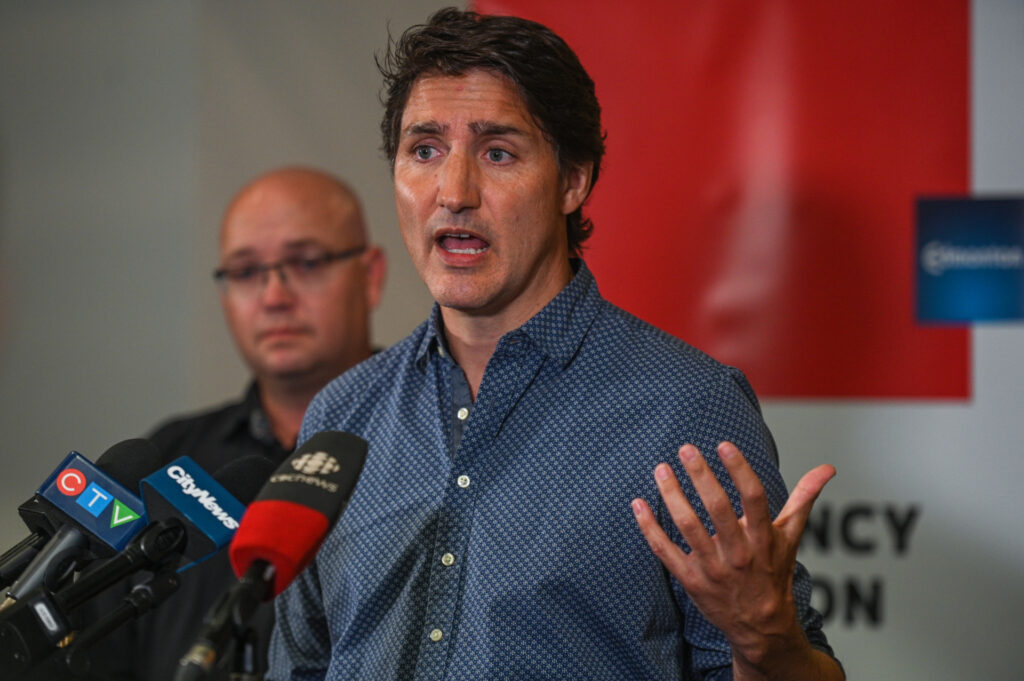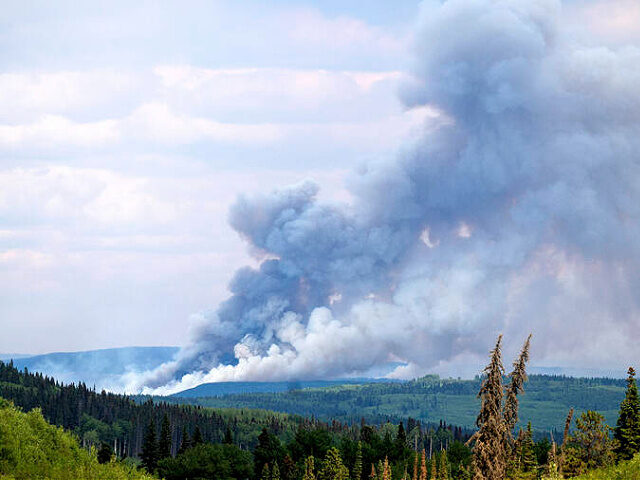Smoke from Canada’s still-burning wildfires once again drifted across the border into the northern United States this week, prompting smoke and haze advisories until Wednesday, although the air quality remained much higher than it was during Canadian wildfire smoke plumes this summer.
“The smoke and haze will likely stay much higher up in the air than it was in June and July, meaning the impacts won’t be nearly as severe for those on the ground. As compared to the summer, when air quality reached hazardous levels, this week will be far less severe,” NBC News in New York explained on Monday.
Flashback: Canadian Wildfire Smoke Casts Haze over Big Apple
Those high-altitude winds and high-pressure zones helped the wildfire smoke travel all the way to Florida, where milky hazes were observed as far south as Miami on Tuesday. The sky in Orlando was visibly tinged orange on Monday evening, triggering “moderate” air quality ratings across the Tampa-Orlando area.
On Tuesday, some surprisingly heavy concentrations of imported Canadian smoke gave parts of Florida the worst air-quality ratings in the country.
“I have lived in Florida for going on about 20 years, and this is the first time I can remember seeing such a thick blanket of smoke. For the past 24 hours, we’ve seen milky white, very hazy conditions across the peninsula,” National Weather Service meteorologist Will Ulrich said from Melbourne, Florida, on Tuesday.
Seattle also reported “unhealthy” air quality on Tuesday due to the Canadian wildfire smoke. New York, Pittsburgh, Atlanta, Los Angeles, and Detroit were among the cities that reported Air Quality Index (AQI) numbers high enough to be considered “unhealthy for some.”
The Canadian government said last week that almost 500 wildfires are still burning out of control. Over 37 million acres have been damaged by the fires this year, a total area comparable in size to New York state.
If anything, the wildfire situation appeared to be growing worse over the past week, after a month of improvements. Some experts said the latest round of fires pumped more carbon emissions into the atmosphere in a matter of days than Canadian fires usually produce during an entire summer.
Canadian environmental officials warn that some evacuation orders remain in place for the foreseeable future.
“We will need to adapt to living with fire. It’s very likely these fires will need to be managed till snowfall,” environmentally ministry spokesman Shane Thompson said in mid-September.
The administration of Canadian Prime Minister Justin Trudeau has been criticized for making the wildfire season worse by having weak forest management policies, underfunded firefighting agencies, and no national firefighting service at all.

Canadian PM Justin Trudeau speaks at Edmonton’s Expo Center transformed into the Emergency Response Center in Edmonton, on August 18, 2023, in Edmonton’s Expo Center, Edmonton, Canada.
(Artur Widak/NurPhoto via Getty Images)
The government would obviously rather talk about global warming, but critics say decades of bad decisions set the stage for this summer’s immense blazes, including dangerous mismanagement policies that left the forests choked with deadwood.
The Pacific Research Institute (PRI) pointed out in July that Canada’s summer wildfire trend was flat, or even decreasing slightly, for almost 40 years before fires began picking up in 2021 — clearly not a result of “climate change,” which has supposedly been getting catastrophically worse for every one of those past 40 years, but because the consequences of poor forest management policies were finally felt.
PRI saw little sign of Canada changing its approach. On the contrary, U.S. states like California are increasingly adopting Canadian-style policies, with the same likely outcome:
Policymakers chose a path that over the last century has turned U.S. forests into “tinder boxes” that are highly “vulnerable to catastrophic wildfire.” Forests are overflowing with accelerants: deadwood, uncontrolled brush and trees that “are packed together at up to five times their natural density.” An unwillingness to perform controlled burns and cut fuel breaks also intensifies fires. The negligence – what else can it be called? – produced fires in 2020 (the year when wildfires hardly registered in Canada) that spewed more carbon dioxide into the atmosphere than all industrial emissions combined.
It’s interesting to note that the same people who believe they can manipulate the climate by restricting human behavior – the combustion of fossil fuels that runs a modern economy – refuse to properly, and responsibly, manage nature.
California adds another layer of “arsonist” policy: Rather than use their scarce resources to update aging equipment that’s been known to start wildfires and keeping areas around power lines clear of accelerants, utilities have poured money into green projects. Could this be why the number of U.S. wildfires has remained constant since 1985 yet over the same time period they somehow grew in California?
The Spectator of Australia glumly noted in June that Trudeau is mostly trying to “improve” the Canadian forest fire situation by raising carbon taxes — the same approach that “hasn’t stopped the fires from happening, hasn’t stopped the (normal) drought cycle, and hasn’t stopped the build up of flammable material within the nation’s sprawling forests.”
Watch: Wildfire Blaze Turns Skyline RED as Wall of Flame Moves Through Canada
Video Source: @sashostak / LOCAL NEWS X /TMX“Science demands a testable relationship between cause and effect, which is something governments avoid at all costs when it comes to mysteriously ineffectual carbon taxes,” the Spectator wrote archly, pointing out that carbon taxes slow down development — which leaves more untamed, overgrown forest to catch fire and produce gigantic conflagrations.
The Spectator recommended Canada get more serious about catching and harshly punishing arsonists and spending less on “green energy” boondoggles so it can spend more on firefighters and forestry.
“The real crime here is the sheer volume of climate and carbon regulation that results in a near-constant extraction of cash from citizens under the haze of ‘saving the world’. It would be interesting to know the true cost of all the individuals and their departments behind this matrix of virtue – and then work out how much fire-fighting equipment could be purchased with that money instead,” the article concluded.

COMMENTS
Please let us know if you're having issues with commenting.